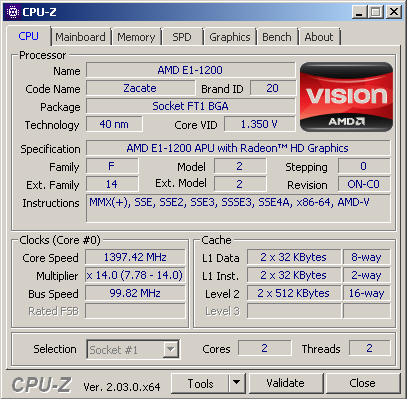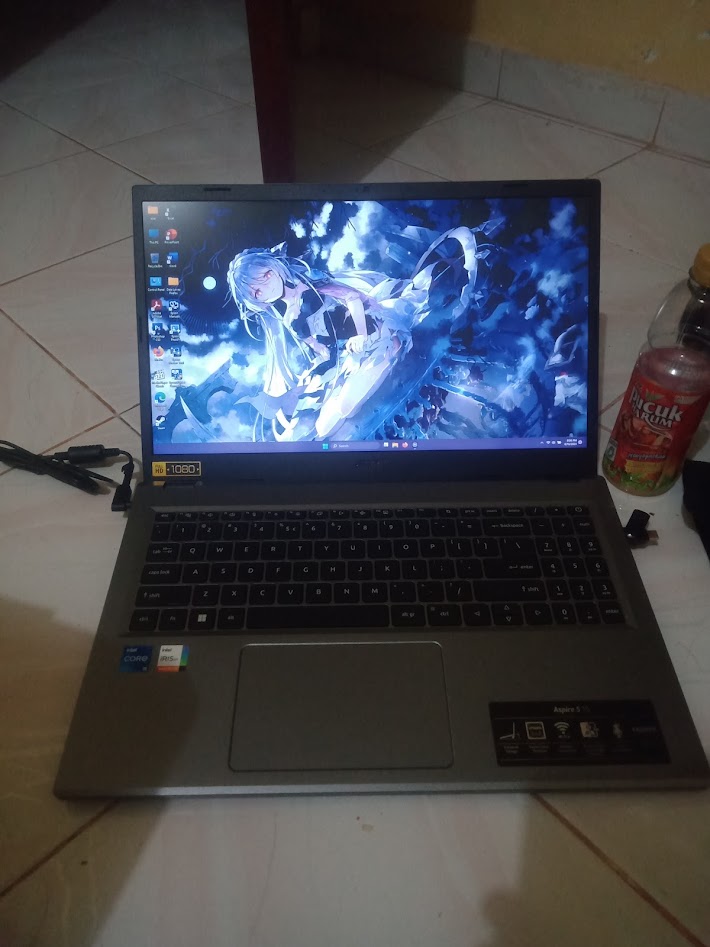Comparing: AMD E1-1200 vs Intel Core i5 1335U
In this comparison, we analyze two Processors: AMD E1-1200 and Intel Core i5 1335U, using synthetic benchmark tests to evaluate their overall performance. This side-by-side comparison helps users understand which hardware delivers better value, speed, and efficiency based on standardized testing. Whether you're building a new system or upgrading an existing one, this benchmark-driven evaluation offers valuable insights to guide your decision.
Specification Comparison Table
This specification comparison presents technical details of several devices or components to help you understand the key differences between each option. Use this table as a reference to determine which device best suits your needs.
| Specification | AMD E1-1200 | Intel Core i5 1335U |
|---|---|---|
| Architecture | x86 | x86 |
| Technology | 40 nm | 10 nm |
| Clock | 1.4 GHz - - | 1.3 GHz - 4.6 GHz (P), 3.6 GHz (E) |
| Core/Thread | 2 / 2 | 10 (2P + 8E) / 12 |
| Segmen | Mobile | Mobile |
Submission Comparison Table
This submission comparison table displays the number and details of benchmark data submissions from various devices or components. This information helps you understand the performance based on the benchmarks that have been tested, as well as providing an overview of the consistency and popularity of the available benchmark results.
| No. | Benchmark Software | AMD E1-1200 | Intel Core i5 1335U |
|---|---|---|---|
| 1 | 7-Zip |
2599 MIPS |
52680 MIPS |
| 2 | AIDA64 GPGPU Benchmark - Single Precision FLOPS |
10.79 GFLOPS |
599.4 GFLOPS |
| 3 | Cinebench - 2003 |
292 cb |
6677 cb |
| 4 | Cinebench - R11.5 |
0.54 pts |
19.45 pts |
| 5 | Cinebench - R15 |
44 cb |
1350 cb |
| 6 | Cinebench - R20 |
79 pts |
3066 pts |
| 7 | Cinebench - R23 Multi Core with BenchMate |
204 pts |
8031 pts |
| 8 | Cinebench - R23 Single Core with BenchMate |
110 pts |
1611 pts |
| 9 | CPU-Z Benchmark - Multi Thread |
108.4 points |
4589.9 points |
| 10 | CPU-Z Benchmark - Single Thread |
57.7 points |
682.1 points |
| 11 | Geekbench3 - Multi Core |
1050 points |
31332 points |
| 12 | Geekbench3 - Single Core |
575 points |
6182 points |
| 13 | Geekbench4 - Multi Core |
1240 points |
31691 points |
| 14 | Geekbench4 - Single Core |
737 points |
7387 points |
| 15 | Geekbench5 - Multi Core |
255 points |
8114 points |
| 16 | Geekbench5 - Single Core |
132 points |
1698 points |
| 17 | Geekbench6 - Multi Core |
193 points |
8689 points |
| 18 | Geekbench6 - Single Core |
107 points |
2285 points |
| 19 | PiFast |
1min, 49sec, 900ms |
13sec, 990ms |
| 20 | SuperPi - 1M |
55sec, 754ms |
7sec, 92ms |
| 21 | SuperPi - 32M |
45min, 28sec, 176ms |
6min, 38sec, 548ms |
| 22 | wPrime - 32M |
1min, 8sec, 78ms |
3sec, 985ms |
| 23 | wPrime - 1024M |
36min, 6sec, 64ms |
3min, 3sec, 230ms |
| 24 | y-cruncher - Pi-25m |
1min, 10sec, 49ms |
1sec, 61ms |
Submission Comparison Chart
This chart visualizes the benchmark scores comparison between two hardware devices based on submitted data.
Media Gallery
A collection of photos of tested hardware. These images can help you identify the physical form, model, and variant of the hardware in question. These photos are from our own documentation, and if they are not available we may not be able to document them.
About Hardware AMD E1-1200
Released in 2012 as part of the Brazos 2.0 family, the AMD E1-1200 is a power-efficient processor aimed at entry-level laptops. It has a 2 core and 2 thread configuration with a fixed clock speed of 1.4 GHz, with no support for Turbo Core technology. Built with a 40nm fabrication process, the E1-1200 has a TDP value of 18 watts-efficient enough for portable devices that emphasize low power consumption and longer battery life. Despite its limited performance, the E1-1200 was a popular choice in its day thanks to its affordable price and ability to handle light computing needs.
One of the main advantages of the AMD E1-1200 is the integrated Radeon HD 7310 GPU, which offers better graphics performance than Intel's entry-level graphics solutions at the time. This GPU has the ability to play HD resolution videos smoothly, as well as run light games such as Counter Strike 1.6, Plants vs Zombies, or other casual games with minimum graphics settings. That said, this combination of CPU and GPU is not intended for heavy-duty work such as video editing, 3D rendering, or modern gaming. Overall performance is more optimal when used for tasks such as browsing, streaming videos, accessing social media, typing documents, as well as basic office applications.
However, it should be noted that the AMD E1-1200 is less suitable for heavy multitasking, especially in modern operating systems like Windows 10. With a low clock speed and no Boost feature, users may experience lag or limitations when opening multiple applications at once. In tests using the HP 1000 1b05au laptop, this processor was paired with 4GB DDR3 single channel RAM (2 DIMM slots) and tested on Windows 7, Windows 8, and Windows 10 operating systems. The results show that the most optimal performance is achieved on Windows 7 or Windows 8, while in Windows 10 the system tends to be slow although it can still be used for basic needs. As such, the AMD E1-1200 can still be relied upon as a power-efficient and inexpensive solution for users with very light computing needs.
Hardware Detail:
Device: HP 1000 1b05au
RAM: 4GB DDR3 Single Channel 2 DIMM
OS: Windows 7, Windows 8, Windows 10
Wednesday, 26 December 2012 14:27:36 | Update: 1 month ago
About Hardware Intel Core i5 1335U
The Intel Core i5-1335U is a mobile processor from the Raptor Lake family, launched in 2023 and aimed at thin-and-light laptops such as ultrabooks. This processor offers a 10-core hybrid architecture, consisting of 2 Performance cores (P-cores) and 8 Efficiency cores (E-cores), delivering a total of 12 threads to handle both heavy workloads and background tasks efficiently. With boost clock speeds up to 4.6 GHz on the P-cores, the i5-1335U provides excellent responsiveness for productivity, multitasking, and modern office applications.
Built on Intel 7 (10nm Enhanced SuperFin) process technology, the i5-1335U maintains a base TDP of 15W, making it suitable for long battery life and efficient thermal management in slim devices. For graphics processing, the integrated Intel Iris Xe Graphics delivers capable performance for video playback, creative work, and casual gaming, especially when paired with dual-channel memory configurations.
The i5-1335U is featured in devices like the Acer Aspire 5 A515-58P, which includes 8GB LPDDR5 RAM (non-upgradeable) and runs on Windows 11 22H2, offering a modern, smooth user experience. Overall, the Core i5-1335U is an ideal choice for students, professionals, and mobile users looking for a balance between performance and energy efficiency in daily computing.
Hardware Detail:
Device: Acer Aspire 5 A515-58P
RAM: 8GB LPDDR5 (Fix, Cannot Upgrade)
OS: Windows 11 22H2
Tuesday, 15 August 2023 13:16:48 | Update: 1 month ago





